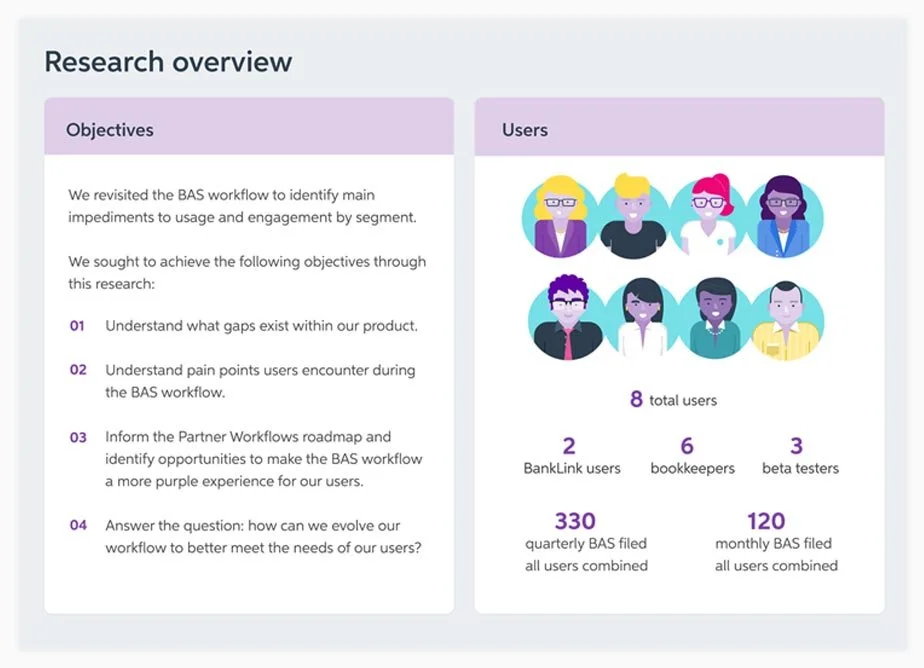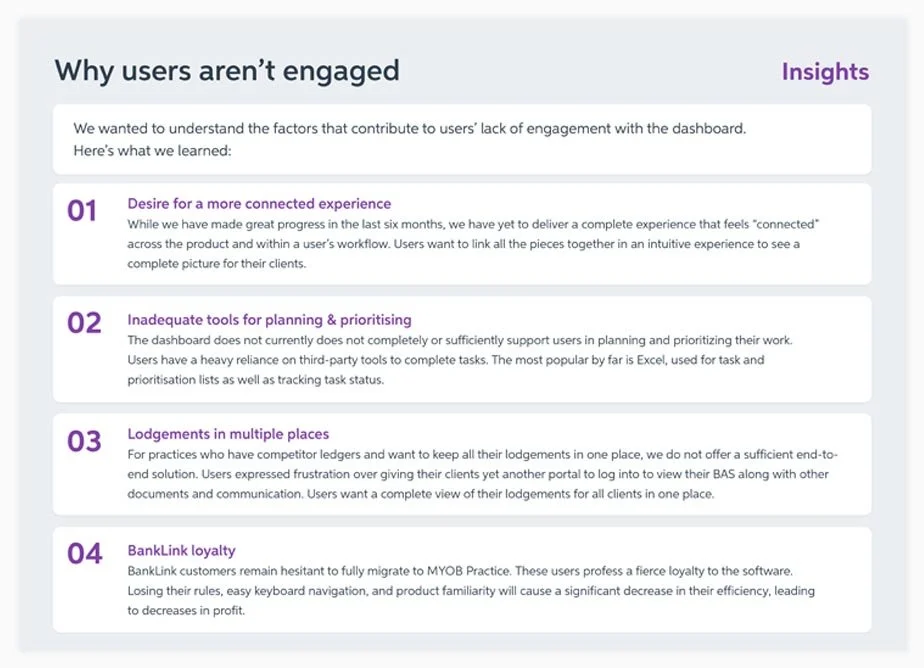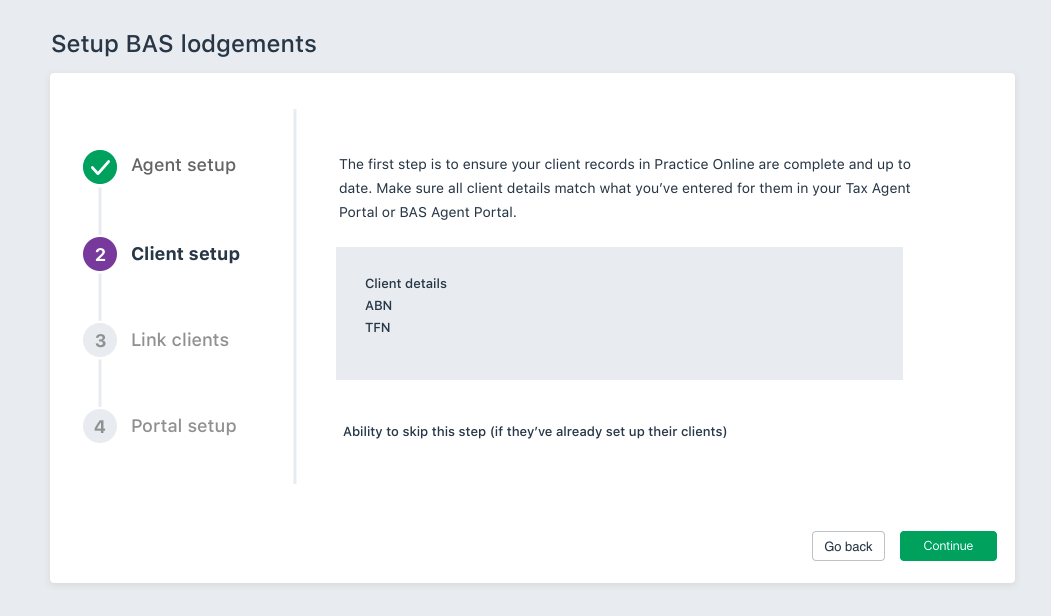myob (Australia)
role. user research & product design
MYOB's B2B product aimed to help bookkeepers in Australia and New Zealand streamline their workflows, particularly in filing Business Activity Statements (BAS). While the product team believed they understood the BAS workflow, there was a need to revisit it to identify gaps and pain points—both in bookkeepers' processes and within the product.
research goals
Based on an understanding of the gaps in our current knowledge, I determined the following research goals:
Identify gaps in the existing product and assess how well it supports bookkeepers.
Understand bookkeepers' pain points throughout the BAS workflow and what workarounds they use for tasks.
Determine how to evolve the product workflow to better meet user needs while delivering an improved experience.
Inform the product roadmap for the next three quarters with user-driven insights.
stakeholder management & research execution
To ensure alignment with business goals, I collaborated closely with product managers, developers, and QA teams from the start. I structured a user research plan that combined qualitative interviews with in-person observation of bookkeepers using the product in their daily workflow.
Research planning & stakeholder buy-in
Developed a research guide based on known BAS workflow steps.
Aligned research objectives with product management to ensure insights would inform roadmap decisions.
Secured stakeholder engagement by inviting them to participate in interviews.
User interviews & collaborative research
Conducted eight interviews with current product users (bookkeepers).
Observed users navigating the system, probing into pain points and desired features.
Captured findings in a shared document for real-time stakeholder access.
Introduced collaborative research workflow by inviting developers and product managers to join sessions to hear firsthand insights from users.
collaborative research synthesis
To translate findings into actionable insights and promote the collaborative research workflow, I led a synthesis process designed to engage the entire product team. I did this by:
Creating a wall of insights
I transformed raw interview data into an insights wall in the center of the product team’s workspace, using sticky notes so the team could engage with something tangible.
I organized findings according to each phase of the workflow, highlighting pain points, direct quotes, and variations in user behavior observed during that phase.
I encouraged team discussions. The insights wall became a focal point for conversations about how we improve the product experience, with developers, QA analysts, and the product owner all contributing their perspectives and potential solutions.
Emotion mapping
I created an emotion map illustrating each phase of the BAS workflow, and mapped bookkeepers' emotional highs and lows, using direct quotes to add context.
This visual tool helped prioritize feature development by showing the greatest points of user frustration and the parts of the workflow that benefit from increased efficiency.
BAS workflow emotion map, informed by research insights
influencing strategy & roadmap decisions
With synthesized insights, I structured a four-part narrative to communicate findings effectively:
1 User pain points & gaps – key areas where the product failed to support bookkeepers.
2 Workflow mapping – demonstrated inefficiencies and areas of confusion.
3 Product recommendations – proposed feature improvements backed by user insights and measured by the highest impact on the user, mapped to the current product roadmap.
4 Conceptual solutions – provided high-level designs and prototypes illustrating potential improvements and new product features.
I delivered these findings to the full product team, including developers, product managers, and analysts. The research I conducted enabled data-driven decision-making, with user insights directly influencing the next two quarters of the roadmap. I also equipped developers with first-hand knowledge of the users they build products for every day, allowing them to advocate for user needs in technical discussions.
pages from the final report including opportunities & product recommendations presented to the team
prototyping a new workflow
Armed with research insights, I designed prototypes to streamline the BAS workflow, focusing on two primary improvements:
1 Dashboard enhancements
Introduced a client details drawer, reducing the amount of screen switching users have to do and improving workflow efficiency.
Aligned with bookkeepers' need for increased visibility into client data.
2 Introduction of BAS workflow setup
Created a single-step workflow for first-time BAS setup, a process that didn’t currently exist but would save bookkeepers a lot of time and energy.
Improved task visibility, ensuring bookkeepers understood the process upfront.
concepts showing improvements to the dashboard and a new setup workflow
project outcomes & impact
Improved stakeholder alignment – developers and product managers gained a deeper understanding of user needs, leading to stronger collaboration across the team.
User-centric product roadmap – research directly shaped the next two quarters of development priorities and clearly showed what the priorities should be.
More efficient user workflows – proposed design changes reduced friction in BAS filing, enhancing satisfaction of long-time users of the product.
Cross-functional research workflow – developers became active participants in research, improving user advocacy and shared knowledge across the team. I observed an improvement among developers in their thought process on implementing new features, putting users first.








